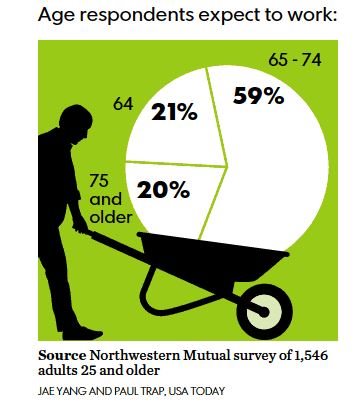Why Older Workers are More Cost Effective

The number of older workers in the workforce is not only growing, it is growing faster than any other age group and older Americans want to continue working; seventy-nine percent of respondents in this survey indicate they will not retire until after 65.

Another 86 percent of business professionals plan to continue working once they’re eligible to retire.
This BLS chart shows the increase by age group, so employers that have developed programs to utilize older workerswill have a substantial advantage over those who have not, and they will also have an expanded labor pool for recruitment.
Age Age Age Age Age Age
60-64 65-74 75-84 85+ 60 & older 65 & older
2010 16,757,689 21,462,599 13,014,814 5,751,299 56,986,401 40,228,712
2020 21,008,851 32,312,186 15,895,265 6,597,019 75,813,321 54,804,470
2030 20,079,650 38,784,325 24,562,604 8,744,986 92,171,565 72,091,915
2040 20,512,884 36,895,223 30,145,467 14,197,701 101,751,275 81,238,391
2050 23,490,423 40,112,637 29,393,295 19,041,041 112,037,396 88,546,973
There are a number of reasons why some employers feel hiring older workers create “hidden” expenses. Listed below are a few research shows are untrue:
1. Older workers take more sick days than their younger counterparts. Surveys prove this is false.
2. Healthcare costs are increased. They are actually less for older workers because most no longer have small children as dependents on their health care plans.
3. Older workers have more absenteeism. Surveys prove this is false.
There are many employers that recognize the strengths of older workers. When the Society for Human Resource Management conducted a survey of attitudes toward older workers, 60 percent of the 308 HR departments surveyed said that older workers are more reliable and 59 percent said older workers have a stronger work ethic than younger ones.
Many employers encourage their retirees to return to work on a seasonal or part-time basis and find less training is required as these employees already know what is expected of them and also understand the company culture.
Reasons employers should hire retirees and older workers on a part-time or temporary basis or for project assignments:
- It is usually not necessary to pay company benefits, like health care insurance.
- Temporary/part-time workers can be off-boarded with comparatively little or no cost.
- If your company has a hiring freeze, hiring temporary/part-time employees usually comes from a different budget.
- Older workers generally require less training, have lower absenteeism and tend to be more punctual.
- Older workers have a better commitment to quality; possess superior customer service skills; have better people skills; and are more eager to learn new skills.
- Older workers have a positive attitude.
- Most temporary, part-time and project-based employees do not require unemployment insurance coverage.
Reaching Older Workers
Many older workers will not apply for positions that may be appropriate for them as they often feel they will be discriminated against because of their age. This is a good reason to go to niche boards that target this demographic. It is also a reason to craft a message tailored to an older worker audience. Check out sites like: RetiredBrains.com, seniors4hire.org, retirementjobs.com and seniorjobbank.org. Some of these sites, like RetiredBrains.com, have posting packages that allow employers to post unlimited jobs.
Employers have used the following to both keep current older workers interested in continuing to work as well as to interest retirees in working for them:
- Programs that allow older workers to work more flexible hours.
- Programs that allow older workers to work part-time jobs or temporary assignments. Managers and executives can work project assignments.
- Programs that allow older workers to work from home or remotely (telecommuting) part or all of the time.
- Job sharing programs for older workers.
- Programs that outsource the task of hiring and employing older workers and retirees that wish to return to work or continue working for those employers that find this difficult to initiate internally.
- Programs that provide recognition and support to older workers as money is not necessarily the most important factor for this demographic.
- Training programs to assist and coach hiring mangers to initiate talks with retirement eligible employees without subjecting the company to problems of age discrimination. In most cases, the costs of training/retraining older workers is substantially less than replacing them when all costs of hiring and training new employees are included.
- Shadowing programs where younger or new employees can learn from first-hand experience the skills retiring employees perform.


